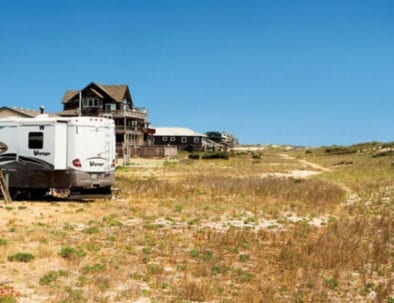TIPS FROM AN RV ROOKIE
We sent an RV novice out on the open road with nothing but a few good friends and a self-contained hotel room on wheels. She logged plenty of bumpy miles on her maiden voyage through North Carolina’s Outer Banks—so you don’t have to. Here is her story—and her advice.
“I studied online forums for RV enthusiasts, campground-review sites, and the orientation video on the RV-rental website.”
Still, in the weeks leading to my maiden RV voyage, my anxiety was rising almost as fast as gasoline prices. The sheer size of the vehicle—and the fact that it would be filled with cutlery and combustible fuels—grew scarier by the minute. To quell the panic, I studied online forums for RV enthusiasts, campground-review sites, and the orientation video on the RV-rental website (twice). And I brought backup: Lindsay and Lola, a couple of friends I’ve known since college who have a generous way of seeing disasters as adventures. They tried to distract me by focusing on our packing priorities: hiking gear vs. lawn games, SPF 15 or 30. Not that it helped.- ROAD-TESTED TIP #1: “Use an RV-specific route planner on a GPS. It’ll factor in overhead clearance and other restrictions, such as which roads, bridges, and tunnels won’t allow propane tanks through.” —Richard Coon, President, Recreational Vehicle Industry Association
“We quickly learned that RV trips are all-hands-on-deck endeavors.”
First came the rattle. With every bump in the road, each cup, dish, and saucepan in our kitchen cabinets shuddered like a beat-up shopping cart being pushed down a gravel road. (I learned later that putting paper towels between the plates helps immensely.) Then came the thuds. Turn left, and one set of drawers would slide open with a thwak. Turn right, and another drawer would do the same. We were already learning that RV trips are all-hands-on-deck endeavors. In addition to navigating, Lindsay was my second set of eyes for lane changes and would become my second-in-command for ticking off setup and breakdown duties. Lola wrangled drawers and cabinets, stood lookout at the rear window for minor back-up missions, and became galley chef for the length of the trip. “This is like a ropes course,” Lindsay said after our first refueling stop, with its propane-off, propane-on, secure-all-items drill. “Maybe we should do some trust falls at the beach.” Six hours, three pit stops, and one possible bird collision (none of us wanted to check the grille for confirmation) later, we arrived at Frisco Campground, one of four in the area run by the National Park Service. We had just enough time to practice back-in parking before nightfall. That’s when I realized my first RV mistake: Anywhere we wanted to go, we’d have to take the RV, repositioning it each time we returned. (The pros either bring bikes or tow a regular car—often referred to as a dinghy—behind the RV.) So we strapped ourselves back in to fetch dinner in Hatteras Village, five miles away, and performed the parking routine again an hour later—this time in the dark, with the girls wielding flashlights like traffic batons.- ROAD-TESTED TIP #2: “We try to bring or rent bicycles to visit nearby areas while camping. It beats packing up the RV to move it to a trailhead for hiking, only to find out there is no room to park a larger vehicle! Many times, you can access a ‘bikes only’ trail or (at the Grand Canyon, for example) trails for shuttle buses and bikes only.” —Debby Schlesinger, BT reader, Grenada Hills, Calif.
“Orchestrating our morning routines was easier than I’d thought.”
Seeing the Frisco campground in daylight—just after sunrise, in fact, thanks to the chatter of the campground’s early risers—provided a fresh perspective after that fitful first night’s sleep. Orchestrating our morning routines was easier than I’d thought. The toilet and the shower—one of those flimsy jobs with a handheld sprayer that tumbles readily from its mount—were bundled in one closet-size room, about four feet by four feet, tops. (Its door was inches away from where Lindsay and Lola slept, another reason to make sparing use of its facilities.) Still, the teensy bathroom sink was just outside the shower/toilet stall; at the slightly larger kitchen sink a few feet away, two people could brush their teeth simultaneously. Lindsay was the first one out, conferring with the park ranger and plotting the day’s activities (hit the beach, visit a lighthouse, find lunch). The ocean’s proximity redeemed the transportation issue. After all, who needs a car when you can walk to the beach? The geography of the Outer Banks—a 130-mile stretch of narrow barrier islands, less than a mile wide for much if its length—was the primary reason I’d chosen this spot for my trial run. There are 20-plus campgrounds along the strip, none much more than a mile away from the Atlantic Ocean or Pamlico Sound. At Frisco, $20 a night buys you peace, quiet, and your own little slice of unlandscaped beachfront real estate. What that $20 doesn’t buy you: heated campground showers or any way to charge a cell phone. Hence, one night would be our limit.- ROAD-TESTED TIP #3: “If you’re exhausted and not near a campground, Walmart stores sometimes allow campers to use their parking lots. Just check to make sure there’s not a no overnight parking sign, and choose a spot near one of the lot’s outer edges.” —Kevin Broom, Director of Media Relations, Recreational Vehicle Industry Association
 The 30 miles of road between Frisco and Rodanthe, where we’d camp next, passes through a series of near-identical hamlets with dreamy names: Avon, Salvo, Waves. The longer we drove, the less I worried about all the folks in my rearview mirror who clearly wanted to pass me on the two-lane highway. Rolling down the windows and turning on the radio helped distract me. So did focusing on our next stop, an oasis where water and electricity flow freely and quiet hours don’t start until a wild-and-crazy 10 p.m.
As much as I’d been obsessing about life inside an RV, pulling into the Cape Hatteras KOA was a revelation. Here, everyone was living outside their vehicles. All around us, colorful awnings, canvas camp chairs, outdoor carpets, wind chimes, string lights shaped like Airstream trailers, plastic gingham tablecloths, tiki torches, and dream catchers marked off each site’s would-be front lawn. We envied our neighbors, a retired duo from Farmville, N.C., for their old-school, beige-striped Winnebago (our RV was plastered with rental ads) and simple setup: an AstroTurf swatch just big enough for their two folding chairs and a small table.
The 30 miles of road between Frisco and Rodanthe, where we’d camp next, passes through a series of near-identical hamlets with dreamy names: Avon, Salvo, Waves. The longer we drove, the less I worried about all the folks in my rearview mirror who clearly wanted to pass me on the two-lane highway. Rolling down the windows and turning on the radio helped distract me. So did focusing on our next stop, an oasis where water and electricity flow freely and quiet hours don’t start until a wild-and-crazy 10 p.m.
As much as I’d been obsessing about life inside an RV, pulling into the Cape Hatteras KOA was a revelation. Here, everyone was living outside their vehicles. All around us, colorful awnings, canvas camp chairs, outdoor carpets, wind chimes, string lights shaped like Airstream trailers, plastic gingham tablecloths, tiki torches, and dream catchers marked off each site’s would-be front lawn. We envied our neighbors, a retired duo from Farmville, N.C., for their old-school, beige-striped Winnebago (our RV was plastered with rental ads) and simple setup: an AstroTurf swatch just big enough for their two folding chairs and a small table.
- ROAD-TESTED TIP #4: “If you’re staying parked in one spot for a while, run the RV engine for a few minutes each day to recharge the battery.” —Tommy Summey, rental agent, Hillsborough, N.C.
“Having a place to spread out is crucial.”
Having a place to spread out is crucial—especially when you’ve crammed a family of four or five into a usable living space the size of a large toolshed. But it would also be a shame to stay inside; an RV park is a voyeur’s paradise—people watching at its most reciprocal. Several times, I passed a man with a white ponytail sitting shirtless outside his RV, shelling peas. He asked how I was doing, and when I replied in kind, he said, “I’m just making do, trying to enjoy myself…it’s not too difficult.” He didn’t need to wink—but I think he did anyway. Our favorite acquaintance at the camp was Kilo, a nervous but friendly tan-and-white Chihuahua that accompanied John, a KOA staffer, on all his rounds—showing new arrivals to their sites and helping campers set up. (The explanation for his name? “He’s from Mexico.” Roger that.) Judging from all the group activities at the campground, it’s safe to say that RVers are very social. Even those campers who’d rather spend their afternoons at the beach—as we did, most days—have ample opportunity for mingling after sundown. One evening, we caught the opening number at karaoke night—Cee Lo Green’s expletive-free radio hit “Forget You,” performed by a teenage staffer; the next, we watched an outdoor screening of Kung Fu Panda. We even organized some social events of our own, enlisting a couple of 30-something Texan guys to help us start a fire to make s’mores. Another snafu: not knowing the proper way to extinguish a fire when you’re done with dessert. We poured panfuls of water from our kitchen onto the flames, sending out smoke signals to the whole campground that we were clueless.“Just as we were leaving, I was getting the hang of it.”
By the last day, we’d had more than our share of screwups, most easy enough to laugh off. But there was one RV task I really couldn’t afford to botch. It was time for the Holding Tank. Lindsay followed me outside to offer moral support—and to remind me to run. Fortunately, I didn’t get my feet wet, though I did leave a small trail of blue chemicals between our site’s dump station and the RV (and hoped no one would notice).- ROAD-TESTED TIP #5: “Be sure to get a tutorial on how to empty the holding tanks. One time, we forgot to add chemicals to the black-water tank after emptying it—the smell was terrible, and we quickly learned our lesson.” —Laurie Huhndorf, BT reader, San Antonio
Written by Valerie Rains. Published by Budget Travel. 09/21/2011









